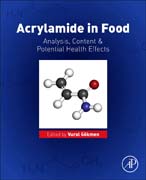
Acrylamide in Food: Analysis, Content and Potential Health Effects provides the recent analytical methodologies for acrylamide detection, up-to-date information about its occurrence in various foods (such as bakery products, fried potato products, coffee, battered products, water, table olives etc.), and its interaction mechanisms and health effects. The book is designed for food scientists, technologists, toxicologists, and food industry workers, providing an invaluable industrial reference book that is also ideal for academic libraries that cover the domains of food production or food science. As the World Health Organization has declared that acrylamide represents a potential health risk, there has been, in recent years, an increase in material on the formation and presence of acrylamide in different foods. This book compiles and synthesizes that information in a single source, thus enabling those in one discipline to become familiar with the concepts and applications in other disciplines of food science. Provides latest information on acrylamide in various foods (bakery products, fried potato products, coffee, battered products, water, table olives, etc.)Explores acrylamide in the food chain in the context of harm, such as acrylamide and cancer, neuropathology of acrylamide, maternal acrylamide and effects on offspring and its toxic effects in tissuesTouches on a variety of subjects, including acrylamide, high heated foods, dietary acrylamide, acrylamide formation, N-acetyl-S-(2-carbamoylethyl)-cysteine (AAMA), acrylamide removal, L-asparaginase, and acrylamide determinationPresents recent analytical methodologies for acrylamide determination, including liquid chromatographic tandem mass spectrometry and gas chromatography-mass spectrometry INDICE: 1- Substances in high heated foods that may cause harm 2- Acrylamide formation mechanism 3- Challenges in estimating dietary acrylamide intake 4- Secular trends in food acrylamide 5 - Acrylamide intake and cancer 6- Neuropathology of acrylamide 7- Maternal acrylamide and effects on offspring 8- Metabolism of acrylamide in humans and biomarkers of the exposure to acrylamide 9- Acrylamide in bakery products 10- Acrylamide in fried potato products 11- Acrylamide in coffee and coffee substitutes 12- Acrylamide in soybean products, roasted nuts and dried fruits 13- Acrylamide in tea products 14- Acrylamide in table olives 15- Acrylamide in battered products 16- Acrylamide in surface and drinking water 17- Interaction between amino and sulfhydryl groups for acrylamide removal 18- Interaction between bioactive carbonyl compounds and asparagine and impact on acrylamide 19- Reducing acrylamide formation by vanadium 20- Effect of inorganic salts on acrylamide formation in cereal matrices 21- Impact of L-asparaginase on acrylamide content in fried potato and bakery products 22- Lipid oxidation promotes acrylamide formation in fat-rich systems 23- Relationship between antioxidants and acrylamide formation 24- Alternative technologies for the mitigation of acrylamide in processed foods 25- Liquid chromatographic tandem mass spectrometry to determine acrylamide in foods 26- Gas chromatography-mass spectrometry to determine acrylamide in foods 27- Quantitation of acrylamide in foods by high-resolution mass spectrometry 28 - Detection of acrylamide by biosensors
- ISBN: 978-0-12-802832-2
- Editorial: Academic Press
- Encuadernacion: Rústica
- Páginas: 520
- Fecha Publicación: 01/09/2015
- Nº Volúmenes: 1
- Idioma: Inglés
